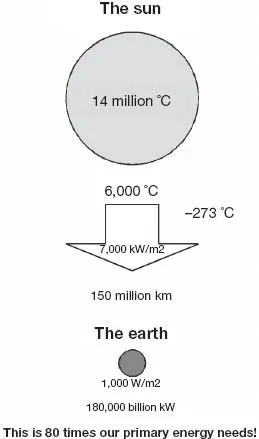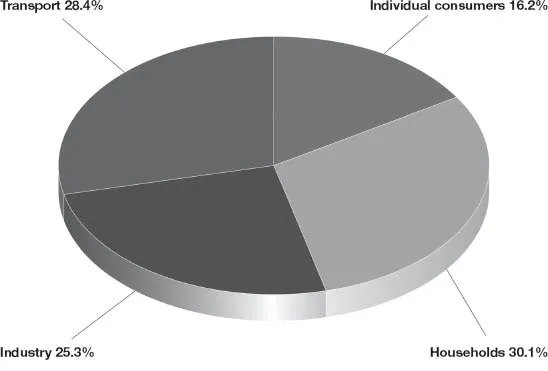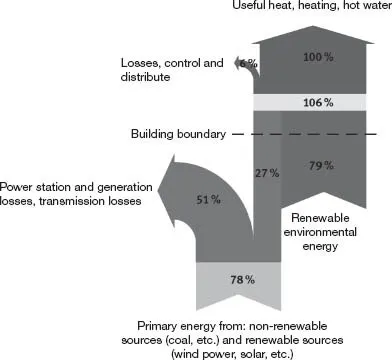![]()
1 Introduction
This book provides a detailed examination of everything relating to heat pumps, and takes into account the most recent developments.
We start with a few observations on ecology and economics.
The reader will find in-depth information about heat pump functions and components, including the characteristics of the various refrigerants. The various types of heat pump are described, and their advantages and disadvantages outlined. Other important areas include an examination of performance, coefficient of performance, seasonal performance factor and energy input factor. It is the author’s intention to increase awareness of the differences between heat pumps and conventional heating systems. Many hydraulic illustrations of heat pump systems are also provided.
A further, newer aspect is environmental and groundwater protection during heat pump operation. Here, we discuss a variety of solutions.
One reader of the first edition found that the book described water-water heat pumps in a very positive light. This is correct. In contrast to the general trend towards brine-water or air-water heat pumps, more importance should be attached to water-water heat pumps because they achieve the optimum degree of efficiency. The author was recently invited to Gelderland in the Netherlands to view a water-water heat pump system in Arnheim with a total output of 2.3 MW! A range of lectures given on the occasion made it clear that the local inhabitants ‘don’t want glycol in the ground’! Our neighbours clearly prefer water-water heat pumps as a means of achieving the energy transition. Of course, other countries will have geological and hydrological conditions different to those in the Netherlands, but we can still learn from one another. And now there is an invention that makes ‘no glycol in the ground’ possible, even for brine-water heat pumps.
The design, planning and selection of hydraulic systems are also extremely important for a heat pump system. As this is where mistakes often occur in practice, it is a subject that will be examined in detail. Planning examples and sample calculations will also be shown.
You will also find helpful hints and explanations on putting heat pump systems into operation.
Chapter 10 discusses whether a heat pump system makes economic sense.
Numerous illustrations and practical examples explore the many issues concerning heat pumps.
![]()
2 Observations on ecology and economics
2.1 Environmental impact
In the new, twenty-first century, two trends in particular are leading to a general change in attitude:
1 the striking increases in energy prices; and
2 the consequences of climate change.
Increasingly, housebuilders, landlords and tenants are considering ways of reducing the extra costs associated with housing. It is incredible, but also very natural, that our thoughts turn first to the impact on our wallets.
Sadly, too little attention is still being paid to increasingly striking climate change because it does not yet have a direct impact on our personal finances. But this can change fast – when, or even before, we, or you, are directly affected.
Figure 2.1 clearly shows the change in climate.
The future is looking warm!
This will have many recognised and frequently cited consequences:
• melting glaciers;
• rising sea levels;
• polar bears drowning and losing their habitats;
• more species of flora and fauna becoming extinct;
• increasing desertification;
• changing climate; and
• more severe storms and hurricanes, and more.
The advantage of global warming is that less energy will be required for heating, but more electrical power will be needed for cooling, ventilators and air conditioning.
This raises the question: Is this what we want? Of course not. But what can we do about it?
Added to this comes the increasing cost of energy and the threats of oil or gas taps being turned off (i.e. dependence on exporting countries).
Figure 2.1 Extreme temperature rises at the turn of the century
Figure 2.2 The sun as a source of energy
Figure 2.3 Energy consumers by share
Figure 2.4 Energy flow in a heat pump
Is there no alternative? Of course there is.
The only way out of this dilemma is greater use of renewable energy. This includes solar power, without which there would be no geothermal energy, because the earth is warmed by the sun. And the sun provides us with 80 times the energy we actually need (see Figure 2.2).
This energy is available for use in a variety of forms:
• through the direct use of solar energy using solar collectors and solar cells;
• through the immediate use of solar energy in the ground using heat pumps; and
• through the use of wind energy.
Figure 2.3 shows that almost one-third of all energy is consumed by households. The largest portion – 88 per cent – is used for heating.
These observations indicate how necessary it is that we start thinking in ecological terms. Figure 2.4 shows that there is also good financial reason for doing so. Using renewable energy makes both ecological and economic sense.
TIP
Those whose primary energy requirements are too high can use the green electricity generated by the major power utilities!
‘The streets are paved with gold’, by which we mean that geothermal energy is directly available, free of charge and in unlimited quantities, right outside our front doors. You only have to pump it out and use it. Geothermal is one of the ultimate forms of renewable energy and is available to everyone. Unlike all other fuels, there is no need to spend – sometimes considerable – amounts of money and energy transporting it to the end user!
And when you consider that 40 per cent of energy in Europe is used for heating and cooling, then the huge importance of heat pumps becomes clear.
Now we need to rethink energy use in Germany. Although the tendency is increasing, only 20 per cent of new builds are currently equipped with a heat pump. In Austria, in contrast, 50 per cent of all new builds have a heat pump, in Switzerland 85 per cent and in Sweden an incredible 95 per cent. This reduces CO2 emissions and takes the pressure off consumers’ wallets, because:
• like solar energy, geothermal energy is free; and
• reduced CO2 emissions mean a better climate and act as a brake on climate change and the natural catastrophes it causes, which cost billions in consequential damages.
When God created our world, He bound up CO2 and other damaging gases in the form of coal, oil and gas, creating a ‘good climate’ for mankind. And what does mankind then do? Mankind is stupid enough to dig up all these valuable resources out of the ground again, burn them and destroy the climate. It does not have to be like this; indeed, it should not be like this. And it is certainly unnecessary because there are many alternatives – one of which is using geothermal energy by means of heat pumps!
We should also consider that valuable resources, such as coal, ga...




